|
FIP Manual, March 1990
Introduction
This guideline explains how government policy on the identification of motor vehicles should be applied. The guidelines and design standards are intended to assist all those involved in ordering, designing, fabricating and procuring vehicle markings.
Applicable publications
This section should be used with the following policies or guidelines:
Communications volume, Treasury Board Manual
- Chapter 1, Government Communications Policy
- Chapter 2, Federal Identity Program
Federal Identity Program Manual
- Section 1.0, Management guide to corporate identity
- Section 1.1, Design
Standard markings
Standard markings have been established to ensure consistency and uniformity in the identification of all government vehicles (Fig. 1). Described here is the system of markings that is intended to meet the different operational requirements and to simplify procurement.
Markings for safety purposes
Certain vehicles require markings to enhance safety. Referred to as safety markings, they increase the visibility of a vehicle. The decision to use safety markings is at the discretion of the institution operating the vehicle.
Generally, safety markings consist of chevron (or similar) striping at the rear of the vehicle, and may include horizontal stripes on both sides of the vehicle. In view of different practices and requirements, these guidelines do not include specifications for such markings.
Other external markings
Decals bearing messages unrelated to corporate identity should not appear in close proximity to the signature and wordmark. Therefore, fleet numbers or similar identifiers should be applied elsewhere on the vehicle to avoid visual conflict.
Purpose
An estimated 16,000 vehicles are operated by institutions subject to FIP. The uniform identification of these vehicles helps the public in recognizing federal activities. The use of standard markings has this purpose:
- to project the corporate identity of the government;
- to identify the institution operating the vehicle;
- to indicate the vehicle’s function, as required.
Vehicle identification also serves to highlight ownership and assists in ensuring accountability on the part of operators. Each institution is responsible for determining the requirement for vehicle identification in accordance with government policy and these guidelines.
Scope
Guidelines and standards set out the requirements for the design, fabrication and placement of vehicle markings. The purpose of these markings is to identify government motor vehicles operated within Canada. The signature and the “Canada” wordmark are the principal elements of vehicle markings.
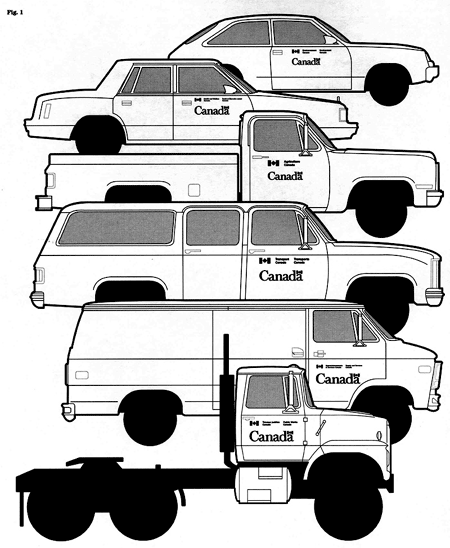
Application
The markings apply to all government (owned or leased) on-road vehicles, with the exception of vehicles on short-term leases and those that have been exempted (see below).
Identification of leased vehicles
Vehicles on long-term leases (90 days and over) should bear standard markings consistent with the design standards. Th identify vehicles on short-term leases, institutions will find it practical to employ temporary instead of the more permanent, standard markings. (See “Temporary identification” for details.)
Exemptions
When an institution finds it is inadvisable to use external markings on a particular vehicle, it may authorize an exemption.
Identification of other mobile equipment
Institutions that operate vehicles or equipment designed for off-road use (e.g. all-terrain vehicles, snowmobiles, boats, construction or maintenance equipment) should assess the requirement for markings on the basis of the principles set out in this guide. The method of identifying such equipment is at the discretion of the institution concerned.
Roles and responsibilities
The roles and responsibilities for implementation are outlined in FIP policy; those pertaining to vehicle identification are indicated below.
Supply and Services Canada (SSC) is responsible for:
- providing markings to clients directly from SSC or through its approved sources of supply;
- ensuring that the markings are in accordance with FIP design standards and applicable CGSB (Canadian Government Standards Board) standards;
- preparing a layout of the proposed markings and providing a copy to the client for approval, if required;
- providing the client with a firm cost quotation for fabricating the markings, if applicable;
- delivering the markings within the time periods established (see “Standards of service”);
- providing clients with order forms, price lists, and installation instructions to facilitate procurement and installation.
Each institution operating government (owned or leased) motor vehicles is responsible for:
- managing the identification of vehicles as part of the corporate identity function;
- determining the requirements for markings with respect to operational needs and in accordance with FIP policy and guidelines;
- procuring all vehicle markings from SSC or, if special arrangements were made with SSC, from SSC approved sources; and
- arranging for the installation of markings in accordance with FIP guidelines.
Corporate identity management
The identification of vehicles should be based on functional and operational requirements, and reflect the corporate goals of the institution. Vehicles that are used for the delivery of government programs and services represent a significant aspect of an institution’s identity. It follows that vehicle identification should be a function of corporate identity management.
In addition to meeting functional requirements, the uniform identification of an institution’s vehicle fleet can also help to project a coherent visual identity. Various methods can be employed to create a distinctive appearance. One method is the adoption of a uniform fleet colour, and a number of institutions are now using a specific colour for that purpose. Another method consists of a graphic device that has a distinct relationship with the markings (e.g. a band in a contrasting colour). Similarly, an institution may use markings in a colour other than the standard black or white. For example, silver-grey instead of white markings could be adopted to create a distinctive appearance for a fleet made up of dark-coloured vehicles.
Implementation
The design standards and guidelines set out here are effective immediately; however, to minimize conversion costs, they should be implemented gradually as follows:
- all new vehicles at the time of acquisition; and
- any existing vehicles that require new markings following re-painting.
Note: Some institutions may presently hold stocks of markings that do not conform to the revised design standards set out here. Such stocks should be replaced as soon as operationally feasible.
Definitions
For purposes of these guidelines the following definitions apply:
Markings refers to pressure-sensitive decals bearing the graphic elements, i.e. the signature of an institution, the “Canada” wordmark, a service title, or a term identifying the vehicle’s function.
Motor vehicles includes passenger cars, cargo vehicles, and special purpose vehicles.
Substrate refers to a surface on which the markings can be applied.

Design standards
Symbols and typeface
To ensure consistency and visual coherence, vehicle markings are subject to design standards. These standards cover the flag symbol, the Coat of Arms, the “Canada” wordmark, as well as the typeface and layout of the signature. The three corporate symbols are described in detail in Section 1.1, “Design”.
The FIP signage typeface is used for all signatures and accompanying text such as service titles. Details on this particular typeface, including its spacing system, are set out in Section 4.5, “Signage typeface”.
The medium-weight version of the “Canada” wordmark is used for all vehicle markings. See Figure 8.
Signature layout
Described here is the layout of the most commonly used signature, one consisting of the flag symbol and two lines of type. In case of a very short signature, users may prefer a one-line signature instead, and should refer to Section 1.1 for details on the layout.
Layout specifications
Measurements pertaining to the signature layout are based on the “x”, the unit of measurement used to indicate space between the elements. The size relationships between symbol and typography and the spacing standards for a two-line signature are as follows.
Ratio between flag and typography: The ratio between the character size and the height of the flag symbol is 1:3.4 (Fig. 2).
Horizontal alignment: The base of the symbol and the base line of the type are aligned horizontally (Fig. 2).
Spacing standards: The space between the symbol and the left-hand column, as well as between the language columns is 3x (Fig. 2).
When a service title is included, the space between signature and service title is 2x (Fig. 3).
Signature incorporating the Coat of Arms
A number of institutions use the Coat of Arms in their signature. For technical details on the layout of signatures incorporating the Coat of Arms see Section 1.1.



Determining the requirements
All markings described here appear on both sides of the vehicle. Before the design or procurement of markings can proceed, specific requirements should be determined.
Language requirements
Under FIP policy, the order of the official languages in the signature is based on the location of the home base of the vehicle concerned. Thus, French appears to the left on vehicles based in Quebec, and English to the left on vehicles located in the other provinces and the territories.
The order of the official languages in the signature and in any accompanying message is the same on both the driver’s and the passenger’s side of a vehicle.
Operational requirements
The design of markings is influenced by factors related to a vehicle’s function and operational requirements.
Identifying a vehicle’s function
The function of certain vehicles (e.g. ambulances, search and rescue vehicles) should be clearly indicated. Normally, this requires markings specifically designed for the vehicle (Fig. 4). This means determining the relative size, placement and use of colour to ensure an effective relationship between the different components (function identifier, signature, wordmark).

A vehicle’s function can also be indicated by means of a service title. Such a title is used in conjunction with the signature and should be as concise as possible (Fig. 5).
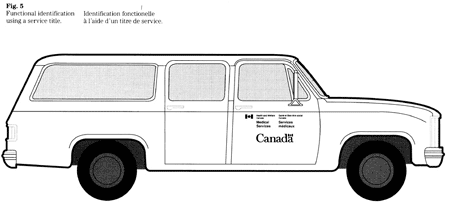
Aspects of visibility
Different functions and operational requirements of government vehicles call for different degrees of visibility. Factors such as vehicle colour, size and colour of markings, and whether or not safety markings are used, will affect the visibility of a vehicle.
Certain vehicles (e.g. ambulances) require a high degree of visibility to ensure they are easily detected and recognized. It follows, that such vehicles need markings that stand out and that should be larger in relation to those used for regular service vehicles.
Institutions should assess the use of retro-reflective materials when specifying markings for vehicles that require night-time visibility.
Ensuring proper fit of the markings
A vehicle’s overall appearance is enhanced by markings of the proper size. To ensure a good fit when installed, the size of markings should be based on the space available on the particular vehicle.
A range of sizes has been established to accommodate signatures varying in length. The standard sizes are intended to meet general requirements for the common vehicle types.
Other sizes are used to meet specific requirements (e.g. markings for a special purpose vehicle, or for a particular fleet).
Colour and contrast
The colour of a particular vehicle determines the colour of markings. For reasons of standardization, black or white is used for the majority of markings.
General applications: Either black or white markings are used to contrast with the body colour of the particular vehicle. The choice between black or white is based on the best contrast that can be obtained. The illustration is intended to assist in the selection (Fig. 6).
Markings appearing on a stripe: Generally, when applied on a white stripe, the markings should be in red and black as follows:
- red flag in the signature and red flag in the “Canada” wordmark;
- black characters in both the signature and the “Canada” wordrnark.
Specifications: For black or white markings, reference should be made to the appropriate number shown in Canadian Government Standards Board (CGSB) standard 1-GP- 12, Standard Paint Colors. The numbers are: black 512-201; white 5 13-201.
A special weather-resistant product should be specified for those elements of the markings that are to appear in red (i.e. the flag). It is referred to as 3M cast in “tomato” red vinyl No. 180 13.

Safety markings
A decision to apply safety markings is at the discretion of the institution operating the vehicle. Generally, these markings consist of chevron (or similar) striping at the rear of the vehicle, and may include horizontal stripes on both sides. Because the horizontal stripe represents an integral part of vehicle identification and usually serves as substrate for the signature and wordmark, the recommended ratio between the width of the stripe and the size of the markings is referred to under “Special requirements”.
Temporary identification
As stated in the “Introduction”, temporary instead of the more permanent, standard markings are used to identify a vehicle on short-term lease. The design of a temporary device should conform to the general requirements on the use of the signature and “Canada” wordmark. The size, colour, and material of such devices are at the discretion of the institution concerned.
For purposes of temporary identification, a device such as a placard is displayed on the vehicle. To meet the intent of FIP policy, the device should be clearly visible to the public. Figure 7 indicates how this may be done.


Selecting the markings
Described here is the system of markings intended to meet common requirements, simplify procurement, and achieve standardization. The system provides for a range of sizes and specific relationships between signature and word-mark when placing the markings on the front doors.
For ease of reference, a code has been established for each standard size; i.e. S-1, S-2, S 3 stand for different x-heights used for the signature, and C-1, C-2 and C-3 refer to sizes of the wordmark. These codes are also used on the order form. The standard sizes are shown in Figure 8.

Standard sizes
Three character sizes have been selected to meet common requirements for signatures. The standard sizes (measured by their x-height) are designated as follows:
- S-1 (10 mm)
- S-2 (12 mm)
- S-3 (15 mm)
Three sizes of the wordmark are used to meet common requirements. The standard sizes are designated as follows (the dimensions refer to the x-height and the corresponding length):
- C-1 (45 mm/320 mm)
- C-2 (55 mm/390 mm)
- C-3 (70 mm/500 mm)
Size and fit
When the markings are to appear on the front doors the following factors will determine the selection of sizes:
- door configuration and length of the signature, i.e. any restrictions that may limit the choice of sizes;
- function and operational requirements; and
- relationship between signature and wordmark, i.e. the visual balance.
As the first step, the approximate length of the signature should be determined with the aid of Table 1. This will ensure that the character size is suitable and that the signature will fit.
As the next step, the sizes of the signature and wordmark should be selected with the aid of Table 2. It shows various options of combining sizes.
Once the appropriate combination has been established, the codes (e.g. S-1/C-1) become key information when procuring and installing markings.
The effect of typical size combinations is shown in Figure 9. The examples indicate how the selection of sizes (Table 2) influences the appearance of markings.

Table 1
Determining the length of a signature
To determine the approximate length of the signature and select a character size:
- Verify the space available on the vehicle (most vehicle doors allow approximately 600 mm).
- Review the three columns below to find your organization’s signature or one that is similar in length.
- Select a character size that ensures a good fit and meets operational requirements for visibility.

Table 2
Combining the signature and wordmark
To choose an appropriate combination:
- Refer to the column for the signature size selected in Table 1 (e.g. S-1, S-2, S-3).
- Find your organization’s signature or one that is similar in length, and select a size combination that appears to provide a good visual relationship between the wordmark and the length of the signature. (See also Figure 9.)
- Refer to the codes (e.g. S-1/C-1) when ordering markings.
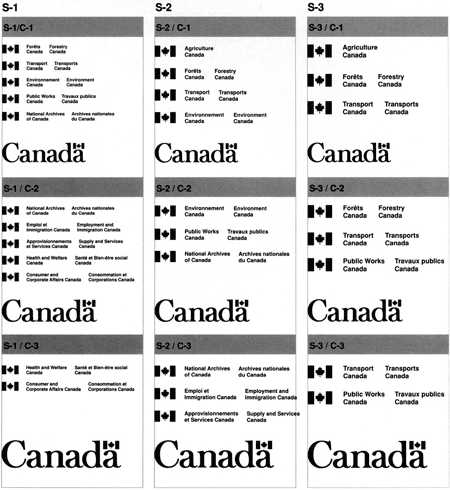
Size of service titles
Normally, service titles should appear in a character size that is larger than the size
used for the institution’s signature (Fig. 10). To create emphasis, the following size relationships between signature and service title may be used: 10 mm and 12 mm; 10 mm and 15 mm; or 12 mm and 15 mm. It is recognized that the relative length of the signature or the service title, as well as any space restrictions may limit the choice of sizes referred to above.


Placement of markings
Markings for each vehicle should be provided in a set, consisting of two decals each of the signature and of the ‘Canada” wordmark in the appropriate colour and sizes established for the type of vehicle. Described here is the positioning of markings on doors, the common method of identifying a vehicle.
Placement on doors
The decals bearing the signature and the wordmark should be positioned on both front doors as shown (Fig. 11). Exact left-to-right and top-to-bottom placement on a door may vary due to variations of shape, contour, attachments or other obstacles.

Space between signature and wordmark
The space between the base line of the signature and the top of the “Canada” wordmark should measure approximately 80 mm (the minimum space is 60 mm). See Figure 12.
Vertical alignment
Generally, the “Canada” wordmark is vertically aligned with the flag symbol of the signature (Fig. 13). In some cases, it may be more effective to centre the wordmark below the signature instead of aligning it on the left (Fig. 14). In view of the many differences with respect to markings and vehicle doors, some judgement will be needed to choose the alignment that appears to be most effective.
In cases where the signature incorporates additional words such as a service title, the wordmark may be vertically aligned with the left column of the text above (Fig. 15).
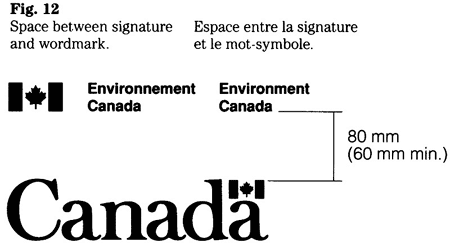

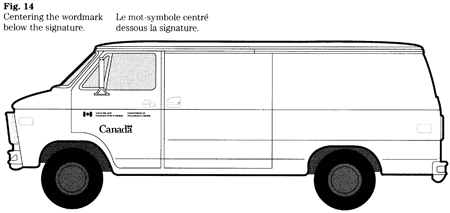


Installation and maintenance
Accurate installation of the markings is essential if the intent of FIP guidelines is to be met. Basic instructions for installing decals are provided with each set. The institution that operates the vehicle should normally issue additional instructions that are specific to the vehicle to be marked.
Ensuring that the appearance of markings will be maintained is part of general vehicle maintenance. Markings that are damaged or deteriorated should be replaced as soon as possible.

Set out here are factors that apply when special requirements have to be met. The selection of markings and sizes will normally require design advice (see “Enquiries”).
In view of the variances with respect to size, type and function of a vehicle, special requirements are treated here by means of suggested practices.
Vehicles bearing a stripe
When designing markings in conjunction with a horizontal stripe, the width of the stripe should be proportional to the size of the vehicle. For example, for purposes of illustrating the vehicle shown in Figure 16, a stripe of 180 mm was used.
Markings that are applied on a horizontal stripe should have certain proportions in relation to the width of the stripe. The suggested ratio between the width of the stripe,
the x-height of the wordmark, and the x-height of the signature is 100:39:11 (Fig. 16). For example, a stripe measuring 180 mm in width would require a wordmark having an x height of 70 mm and a signature of 20 mm.
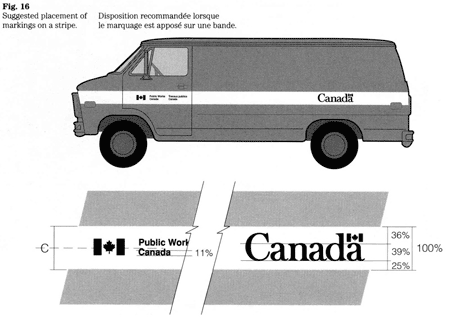
Trucks, trailers and special purpose vehicles
To determine the size and placement of markings, an assessment of the vehicle is required. This should include the operational requirements and the surfaces suitable for the markings. The assessment, as well as a photograph, should be provided when seeking design advice.
The designs shown in Figure 17 indicate several approaches but evidently do not explore all options. It is recommended that markings should be tailored to the particular vehicle.

Substrates for markings
To ensure good adhesion and to avoid distortions, markings should be applied to smooth surfaces. Vehicle bodies consisting of irregular surfaces (e.g. ribbed metal) will require the installation of a suitable substrate (plate) to bear the markings (Fig. 18).
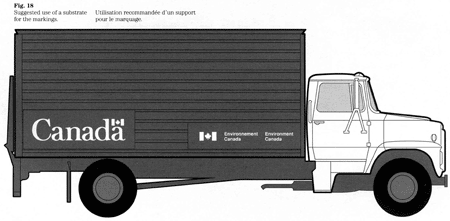
“Canada” wordmark
In addition to displaying the wordmark together with the signature on the front door, the wordmark may also be presented on its own on the sides, rear and front of certain vehicles. Examples are trailers that provide large surface areas allowing an effective display of the wordmark. Generally, the size of the wordmark should be in proportion to the overall surface area (Fig. 19).
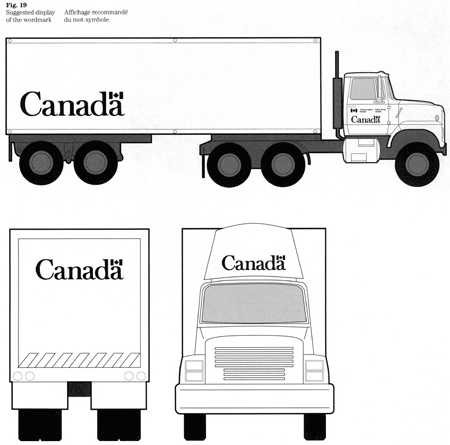

Source of supply
A central source of supply, intended to ensure consistency in the application of design and material standards for all vehicle markings, has been established within Supply and Services Canada (SSC). Use of this source for the supply of markings is mandatory for all departments and departmental corporations named in Schedules I and II to the Financial Administration Act, and for all branches designated as departments for purposes of the Act. Parent corporations named in Schedule III, Part 1 (and subject to FIP policy) are encouraged to use the services and expertise of this source as well.
Standards of service
The following schedule is based on the date that the client provides Supply and Services Canada (i.e. Canadian Government Expositions and Audio-Visual Centre) with a completed order form or a funded requisition (as applicable):
- layout and cost quotation – three weeks;
- production and delivery of the markings – four weeks.
These time frames represent normal delivery schedules. Should a significant delay occur, or is expected to occur, SSC will at once notify the client in writing and provide an explanation for the delay.
Quality control
Both workmanship and materials are the responsibility of SSC. All materials used must be in strict accordance with CGSB standards and FIP design standards. Should defects in workmanship or materials occur, SSC is responsible for rectifying the problem as soon as possible. Warranties on materials are limited to those given to SSC by suppliers and contractors.
Material specifications
All markings are fabricated as pressure-sensitive decals. The following standards and specifications of the Canadian General Standards Board (CGSB) pertain to the materials for markings:
62.3-M Prefabricated Markings, Exterior, for Aircraft
62.8-M Prefabricated Opaque Markings, General Purpose, for Use on Exterior and Interior Surfaces
62.9-M Prefabricated Markings, Positionable, Exterior, for Aircraft, Ground Equipment and Facilities
109.2-M Letters and Symbols, Die-cut Film, FIP
1-GP-12 Standard Paint Colors
1-GP-191M Fast Drying, Automotive Refinishing, Enamel, Gloss
Note: These publications may be obtained from the Canadian Government Publishing Centre, Supply and Services Canada.

Enquiries
Each institution is responsible for implementing these standards and guidelines and has named an official (referred to as FIP Coordinator) to manage its corporate identity. Enquiries regarding the guidelines should be routed through the FIP Coordinator of the institution concerned.
Enquiries on all aspects of design, colour, and the use of the FIP signage typeface should be directed to the Administrative Policy Branch of Treasury Board Secretariat.
Enquiries with respect to the procurement of markings should be directed to the Canadian Government Expositions and Audio-Visual Centre, Supply and Services Canada.
|
